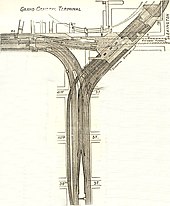42nd Street Shuttle
 42nd Street Shuttle |
|
|---|---|
|
New York Geographical Plan
| |
| Route length: | 1.3 (underground) km |
| Gauge : | 1435 mm ( standard gauge ) |
| Explanations | |
| The left line is the shuttle and the right line 7. The 5th Ave station is only served by line 7, otherwise the shuttle and 7 are parallel. |
|
The 42nd Street Shuttle (also: Grand Central / Times Square Shuttle ) is one of three lines known as the Shuttle ( S ) and, at 1.3 kilometers, the shortest line on the New York subway . It runs between 6 a.m. and midnight, the travel time between the two only stations is one minute. At night, the operation on the parallel line 7 is sufficient.
At the MTA , the line is also referred to as "Line 0" to distinguish it from the other shuttles, the Rockaway (Line H) and Franklin Avenue Shuttle (Line S). It is the only line of the former operator IRT (lines marked with numbers today) that runs underground all the way.
history


The shuttle is a holdover from the original four-track subway that opened on October 27, 1904 from City Hall to the Upper West Side as the city's first subway. The two inner tracks were used by the express trains, the outer by the "locals" stopping at each station.
The station at Grand Central train station has always been an express train station. Times Square was initially only a local station because the square only became famous with the construction of the New York Times headquarters and the general business activity in the city only moved from the southern tip of Manhattan to the center thanks to the subway. When switching to shuttle operation, there was not enough space for a platform on express platform 3, which is why express platform 2 was demolished and a new platform was built along its route.
On August 1, 1918, the line was split and two trunk routes were formed, one along 7th Avenue and Broadway ( IRT Broadway - Seventh Avenue Line , served by ![]() ,
, ![]() and
and ![]() ) and one along South Park Avenue (4th Ave.) and the Lexington Avenue ( IRT Lexington Avenue Line , operated by
) and one along South Park Avenue (4th Ave.) and the Lexington Avenue ( IRT Lexington Avenue Line , operated by ![]() ,
, ![]() ,
, ![]() and
and ![]() ).
).
This made the network of the IRT H-shaped, with the horizontal bar representing the new S-Shuttle. The former express track 2 to the south was removed on the occasion of a platform conversion at Grand Central Station, the former express track 3 ends there bluntly today. The northernmost platform 4 (formerly "local") is still connected to the IRT Broadway - Seventh Avenue Line , the "Local" platform 1 and - indirectly - platform 3 is still connected to the IRT Lexington Avenue Line . A continuous operation of z. B. 125th Street to City Hall or back is not possible due to the lack of a switch connection between tracks 3 and 4. In Times Square, most of the former tracks are still in place; at the north-western end of the station they were only spanned with pedestrian walkways at platform level.
The 42nd Street Shuttle will be rebuilt from 2019 to 2022. The MTA is investing 750 million US dollars to enable barrier-free access, economical train lengths and more efficient operations management. After completion, only the two previous outer tracks will remain, on each of which a six-car train will commute.
business
The train material consists of vehicles of type R62A, of which a total of 825 copies were built between 1985 and 1987. On the 42nd Street Shuttle, cars from the 1900 series are used as three- and four-car trains. The ten vehicles on the route belong to the inventory of the Jerome Yard depot in the borough of Norwood ( The Bronx ).
Each track is used by its "own" shuttle train in both directions. The trains have a driver at each end in order to enable a dense cycle through a quick change of direction. According to the timetable, a train takes 1 to 3 minutes to travel.
Between January 4, 1962 and 1964, automatic train operation was tested on track 4. The train equipped in this way was destroyed on April 21, 1964 in a fire in Grand Central Station.
See also
- Waterloo & City Line (shortest line on London Underground )
- Métrolinie 3bis (shortest line of Métro Paris )
- U-Bahn line 55 (Berlin) (former line of the Berlin U-Bahn )
Web links
- MTA website
- Project website of the MTA (English): Transforming the 42 St Shuttle
- New York Subway's unofficial website
- Timetable ( Memento from February 21, 2014 in the Internet Archive )







